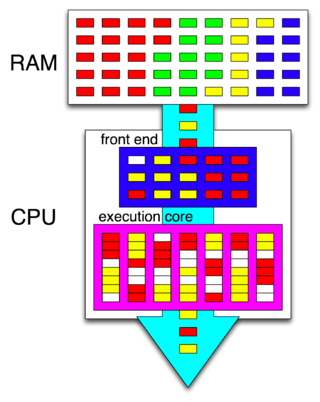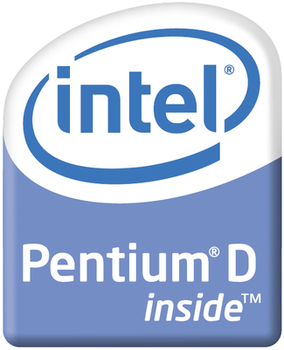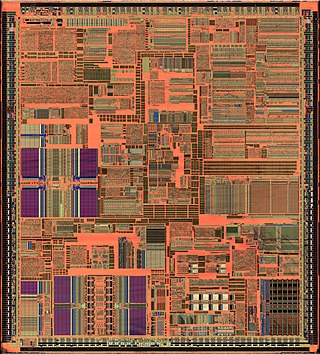
A central processing unit (CPU), also called a central processor, main processor, or just processor, is the most important processor in a given computer. Its electronic circuitry executes instructions of a computer program, such as arithmetic, logic, controlling, and input/output (I/O) operations. This role contrasts with that of external components, such as main memory and I/O circuitry, and specialized coprocessors such as graphics processing units (GPUs).

A superscalar processor is a CPU that implements a form of parallelism called instruction-level parallelism within a single processor. In contrast to a scalar processor, which can execute at most one single instruction per clock cycle, a superscalar processor can execute more than one instruction during a clock cycle by simultaneously dispatching multiple instructions to different execution units on the processor. It therefore allows more throughput than would otherwise be possible at a given clock rate. Each execution unit is not a separate processor, but an execution resource within a single CPU such as an arithmetic logic unit.

Celeron is a series of IA-32 and x86-64 computer microprocessors targeted at low-cost personal computers, manufactured by Intel from 1998 until 2023.

Hyper-threading is Intel's proprietary simultaneous multithreading (SMT) implementation used to improve parallelization of computations performed on x86 microprocessors. It was introduced on Xeon server processors in February 2002 and on Pentium 4 desktop processors in November 2002. Since then, Intel has included this technology in Itanium, Atom, and Core 'i' Series CPUs, among others.

Pentium 4 is a series of single-core CPUs for desktops, laptops and entry-level servers manufactured by Intel. The processors were shipped from November 20, 2000 until August 8, 2008. All Pentium 4 CPUs are based on the NetBurst microarchitecture, the successor to the P6.

The Pentium Pro is a sixth-generation x86 microprocessor developed and manufactured by Intel and introduced on November 1, 1995. It introduced the P6 microarchitecture and was originally intended to replace the original Pentium in a full range of applications. Later, it was reduced to a more narrow role as a server and high-end desktop processor. The Pentium Pro was also used in supercomputers, most notably ASCI Red, which used two Pentium Pro CPUs on each computing node and was the first computer to reach over one teraFLOPS in 1996, holding the number one spot in the TOP500 list from 1997 to 2000.
Tejas was a code name for Intel's microprocessor, which was to be a successor to the latest Pentium 4 with the Prescott core and was sometimes referred to as Pentium V. Jayhawk was a code name for its Xeon counterpart. The cancellation of the processors in May 2004 underscored Intel's historical transition of its focus on single-core processors to multi-core processors.
In computer engineering, instruction pipelining is a technique for implementing instruction-level parallelism within a single processor. Pipelining attempts to keep every part of the processor busy with some instruction by dividing incoming instructions into a series of sequential steps performed by different processor units with different parts of instructions processed in parallel.
Simultaneous multithreading (SMT) is a technique for improving the overall efficiency of superscalar CPUs with hardware multithreading. SMT permits multiple independent threads of execution to better use the resources provided by modern processor architectures.
The NetBurst microarchitecture, called P68 inside Intel, was the successor to the P6 microarchitecture in the x86 family of central processing units (CPUs) made by Intel. The first CPU to use this architecture was the Willamette-core Pentium 4, released on November 20, 2000 and the first of the Pentium 4 CPUs; all subsequent Pentium 4 and Pentium D variants have also been based on NetBurst. In mid-2001, Intel released the Foster core, which was also based on NetBurst, thus switching the Xeon CPUs to the new architecture as well. Pentium 4-based Celeron CPUs also use the NetBurst architecture.

Pentium D is a range of desktop 64-bit x86-64 processors based on the NetBurst microarchitecture, which is the dual-core variant of the Pentium 4 manufactured by Intel. Each CPU comprised two cores. The brand's first processor, codenamed Smithfield and manufactured on the 90 nm process, was released on May 25, 2005, followed by the 65 nm Presler nine months later. The core implementation on the 90 nm Smithfield and later 65 nm Presler are designed differently but are functionally the same. The 90 nm Smithfield contains a single die, with two adjoined but functionally separate CPU cores cut from the same wafer. The later 65 nm Presler utilized a multi-chip module package, where two discrete dies each containing a single core reside on the CPU substrate. Neither the 90 nm Smithfield nor the 65 nm Presler were capable of direct core to core communication, relying instead on the northbridge link to send information between the two cores.
The megahertz myth, or in more recent cases the gigahertz myth, refers to the misconception of only using clock rate to compare the performance of different microprocessors. While clock rates are a valid way of comparing the performance of different speeds of the same model and type of processor, other factors such as an amount of execution units, pipeline depth, cache hierarchy, branch prediction, and instruction sets can greatly affect the performance when considering different processors. For example, one processor may take two clock cycles to add two numbers and another clock cycle to multiply by a third number, whereas another processor may do the same calculation in two clock cycles. Comparisons between different types of processors are difficult because performance varies depending on the type of task. A benchmark is a more thorough way of measuring and comparing computer performance.

The P6 microarchitecture is the sixth-generation Intel x86 microarchitecture, implemented by the Pentium Pro microprocessor that was introduced in November 1995. It is frequently referred to as i686. It was planned to be succeeded by the NetBurst microarchitecture used by the Pentium 4 in 2000, but was revived for the Pentium M line of microprocessors. The successor to the Pentium M variant of the P6 microarchitecture is the Core microarchitecture which in turn is also derived from P6.
The Intel Core microarchitecture is a multi-core processor microarchitecture launched by Intel in mid-2006. It is a major evolution over the Yonah, the previous iteration of the P6 microarchitecture series which started in 1995 with Pentium Pro. It also replaced the NetBurst microarchitecture, which suffered from high power consumption and heat intensity due to an inefficient pipeline designed for high clock rate. In early 2004 the new version of NetBurst (Prescott) needed very high power to reach the clocks it needed for competitive performance, making it unsuitable for the shift to dual/multi-core CPUs. On May 7, 2004 Intel confirmed the cancellation of the next NetBurst, Tejas and Jayhawk. Intel had been developing Merom, the 64-bit evolution of the Pentium M, since 2001, and decided to expand it to all market segments, replacing NetBurst in desktop computers and servers. It inherited from Pentium M the choice of a short and efficient pipeline, delivering superior performance despite not reaching the high clocks of NetBurst.

Yonah is the code name of Intel's first generation 65 nm process CPU cores, based on cores of the earlier Banias / Dothan Pentium M microarchitecture. Yonah CPU cores were used within Intel's Core Solo and Core Duo mobile microprocessor products. SIMD performance on Yonah improved through the addition of SSE3 instructions and improvements to SSE and SSE2 implementations; integer performance decreased slightly due to higher latency cache. Additionally, Yonah included support for the NX bit.

Pentium is a series of x86 architecture-compatible microprocessors produced by Intel from 1993 to 2023. The original Pentium was Intel's fifth generation processor, succeeding the i486; Pentium was Intel's flagship processor line for over a decade until the introduction of the Intel Core line in 2006. Pentium-branded processors released from 2009 onwards were considered entry-level products positioned above the low-end Atom and Celeron series, but below the faster Core lineup and workstation/server Xeon series.

The history of general-purpose CPUs is a continuation of the earlier history of computing hardware.

In computer architecture, multithreading is the ability of a central processing unit (CPU) to provide multiple threads of execution.










